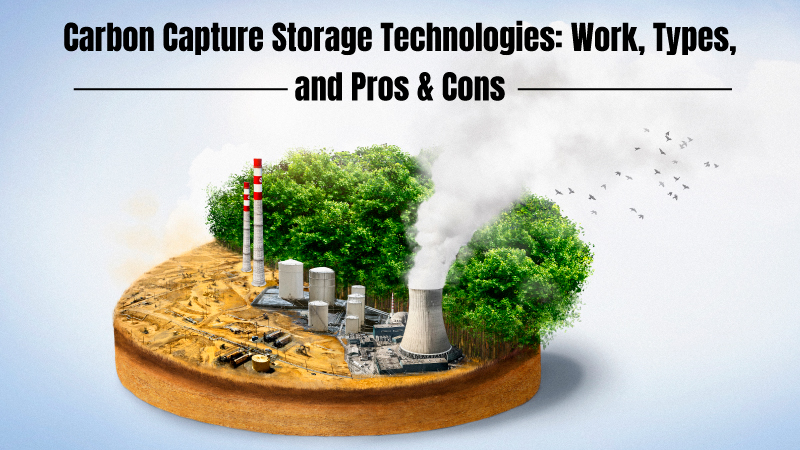
A technique called carbon capture and storage (CCS) aims to lessen the quantity of carbon dioxide (CO₂) that is emitted into the environment. Since one of the main greenhouse gases that results in climate change is CO₂, CCS provides a means of reducing emissions from factories, power plants, and oil and gas operations. This procedure entails removing CO₂ from the atmosphere, properly burying it, and preventing environmental damage.
This informative draft will provide you with all of the details of carbon capture storage technology along with their working, types and pros and cons. Let’s dive deeper.
What is Carbon Capture Storage?
The process of separating carbon dioxide (CO2) from industrial facilities before releasing it into the atmosphere and then transporting it to a long-term storage facility is known as carbon capture and storage, or CCS. The CO2 is usually held in a deep geological formation after being extracted from a major point source, like a natural gas processing facility.
Enhanced oil recovery (EOR), which involves injecting CO2 into partially depleted oil reservoirs to retrieve more oil before it is mostly abandoned underground, uses about 80% of the CO2 captured each year. CCS is often referred to as carbon capture, utilization, and storage (CCUS) because EOR uses the CO2 in addition to storing it. The carbon capture has started since a longer time in history.
History of Carbon Capture Storage
Origins of CCS: In the middle of the 20th century, oil and gas industries began utilizing carbon capture and storage (CCS) techniques.
Early Uses (1950 Onwards): The first CCS technologies were created to improve oil production and purify natural gas.
Environmental Talks (1960 Onwards): Later, CCS was suggested as a way to cut greenhouse gas emissions.
Project Failure Rates: About 70% of CCS projects that were announced have not come to fruition.
- The failure rate in the electrical industry is higher than 98 percent.
- Till 2024, there are 44 CCS plants in operation worldwide.
- Together, these plants absorb around one thousandth of the world’s greenhouse gas emissions.
Industry Involvement (1990 Onwards): The oil and gas sector is associated with 90% of CCS activities.
Impact on Energy and Pollution:
- CCS plants need more energy to survive.
- As a result, more fossil fuels are burned, and pollution from fuel extraction and transportation rises.
These are some details of CCS about its beginning. It represents the exact use of CCS to the industries while highlighting its main role.
Role of CCS in Mitigating Climate Change
Carbon capture and storage, or CCS, has the potential to be a vital but constrained tool for lowering emissions and addressing climate change.
In comparison to CCS, other emission reduction strategies, including electrification, public transportation, solar and wind energy, and others, are more affordable and efficient at lowering air pollution.
CCS is seen to be most helpful in certain sectors because of its capability to reduce environmental impacts.
Key sectors where CCS is utilized are:
- Heavy Industry
- Plant Retrofits
CCS can assist in mitigating emissions from natural gas processing in the context of lowering natural gas consumption.
CCS is intended to supplement the larger transition to renewable energy sources in the production of hydrogen and power.
CCS is also a component of BECCS (Bioenergy with Carbon Capture and Storage), which has the ability to extract carbon from the atmosphere under specific circumstances.
Working of Carbon Capture Storage Technology
Approximately 45 million tons of CO2 are stored annually by CCS projects, which is equivalent to the CO2 emissions produced by 10 million passenger automobiles. Large stationary sources of CO2, such as power plants or industrial facilities that produce chemicals, steel, and cement, are often where capture occurs.
Although a number of novel capture techniques are being developed, the majority of carbon capture plants now in operation use a liquid to chemically extract the CO2 before it exits the flue.
After being captured, the CO2 gas is compressed to a liquid state and sent to a storage location, usually via a pipeline. Although ship transportation is more costly than pipeline transportation, both Europe and Japan are considering it.
The CO2 is transported to the storage location by pumping it more than 2,500 feet down wells into geological formations, such as depleted gas and oil reserves and formations that contain salty, unsuitable water. To achieve better carbon capture, three primary capture technologies are put into service.
Three Main Carbon Capture Technologies
Below are three main carbon capture technologies that help attain better carbon capture while reducing the environmental impact.
- Pre-Combustion Carbon Capture
Pre-combustion carbon processes capture carbon before fossil fuel combustion is complete. When natural gas, coal, or oil is heated with steam and oxygen, or synthesis gas is created.
The gas is made up of hydrogen, carbon dioxide, and carbon monoxide. Water is then converted to hydrogen by the process. Carbon monoxide is changed into carbon dioxide during this process. The end effect is the production of a gas that contains a combination of carbon dioxide. It is possible to sequester, segregate, and trap the combination. Other energy-generating processes can make use of the hydrogen.
When compared to post-combustion carbon capture, pre-combustion carbon capture is frequently more successful and efficient. Compared to alternative methods, the equipment is more costly.
- Post-Combustion Carbon Capture
Carbon dioxide is captured when fossil fuels are burned. Flue gases, which include sulfur dioxide, nitrogen, water vapor, carbon dioxide, and nitrogen, are released when fossil fuels burn.
In a post-combustion process, carbon dioxide is extracted and separated from the flue gases produced by burning fossil fuels. The most widely used carbon-capture technology is post-combustion capturing. This is because of its ability to be utilized in both new and existing coal-fired power plants. There are certain difficulties with this technique, such as the need for large machinery to operate, which may reduce the turbines’ efficiency.
- Oxy-Fuel Combustion Carbon Capture
When fossil fuels are burned, ordinary air is not used. Rather, the combustion process uses a mixture of high amounts of pure oxygen.
The main constituents of the flue gas generated during burning are carbon dioxide and water. The carbon dioxide in the flue gas can be separated by compressing and chilling it.
The fact that oxy-fuel combustion capture is applicable to both new and old coal-burning facilities is one of its advantages. Although some of the components are typically cheap, the procedure as a whole is somewhat costly.
These are three main technologies utilized in capturing carbon. Utilizing these capturing methods offers several advantages as well as some disadvantages.
Pros and Cons of Carbon Capture Storage Technologies
Pros of Carbon Capture
- One of the most effective ways to permanently remove carbon emissions from the environment is through carbon capture and storage.
- Economic, social, and environmental benefits are only a few of CCS’s many advantages. It also has a significant impact both locally and globally.
- The power produced by carbon dioxide-based steam cycles can be increased through carbon capture. By forcing carbon dioxide through a supercritical fluid, this method may improve heat transfer and use less energy to compress steam.
- Sustainable geothermal energy can be produced by using geologically stored carbon dioxide to recover geothermal heat from the injected area.
- Additionally, carbon dioxide captured by carbon capture can be used to make chemicals and polymers like polyurethanes.
- In order to strengthen concrete and extend the infrastructure’s lifespan, the captured carbon dioxide is mixed into it. Because they must be operated, the carbon capture processes generate jobs for qualified engineers and technicians.
Cons of Carbon Capture
- Since carbon capture lowers the amount of carbon emitted into the atmosphere, it is acknowledged as one of the ways to combat global warming and climate change. Nevertheless, there are certain drawbacks to carbon capture and storage (CCS).
- There are some financial ramifications to the carbon capture techniques and CCS systems required. Therefore, using fossil fuels to generate energy can be quite expensive for power plants.
- The potential for leaks, which can cause environmental pollution if not managed properly, raises a number of questions regarding the safety of storing large amounts of carbon dioxide in one place.
- Natural disasters like earthquakes or man-made events like war-related damage that affect subterranean storage reservoirs may also put subsurface storage reservoirs at risk of leaks.
- The economic viability of storing basalt formations has been questioned by numerous detractors. Each ton of carbon dioxide buried under this option will require 25 tons of water. Another issue is the potential for volcanic rock bacteria to break down the carbonates and release methane gas as a byproduct.
- The fact that carbon capture storage is insufficient to effectively address climate change is another drawback. Transportation, agriculture, and other associated industrial activities are responsible for 60% of all greenhouse gas emissions, while emissions from the use of fossil fuels to generate heat and power only make up around 25% of overall emissions. At the moment, carbon capture and storage is not capturing these emissions.
Regardless of the disadvantages of carbon capture methods, the latest technological trends are now stepping forward in changing the future outlook of carbon capture technology.
Future Outlook of Carbon Capture Storage
It is the best approach to choose energy sources that are less harmful to the environment and produce fewer greenhouse emissions. To accomplish this, we must first focus on industries that produce a significant level of carbon emissions.
Production, agriculture, and the oil and gas industries are only a few examples. To reduce the excessive emissions produced by these businesses, carbon capture storage is a superior solution.
If carbon capture businesses continue to grow and develop, carbon emissions from the environment will be minimized, paving the path for the above industries to be sustainable.
Conclusion
Carbon capture and storage or CSS is the most important method that helps reduce the emissions, especially from industries such as oil and gas. As CO2 causes climate change and environmental damage, so it must be captured, transferred, and stored securely.
Even though the CSS helps to the reduction of climate change, it also raises several issues. These issues can be increased expenses, storage security concerns, a limited focus on global emissions, and energy requirements. CSS when combined with renewable energy sources, it becomes an important technique for reducing maximum emissions.
Despite the problems raised above, CSS technologies will continue to reduce emissions, making them one of the most sustainable solutions in the future.
Write and Win: Participate in Creative writing Contest & International Essay Contest and win fabulous prizes.


